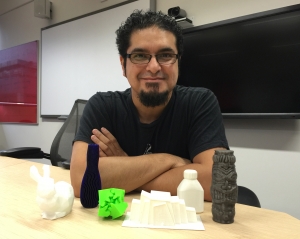Exploring 3D printing pozibilities
Research news
Forget playdough or paper mache. The primary school of the future looks likely to include a 3D printer in the classroom.
Deakin researcher Dr George Aranda is passionate about introducing young people to the benefits of technology. He has raised $5000 to pilot a project that could mark the beginning of 3D printing in Australian primary schools.
Through Deakin’s “Research my World” Pozible initiative, he has been successful in raising the funds needed to trial the use of a 3D printer in one or two Victorian primary schools, either in Geelong or Melbourne, as the first step in the process.
Dr Aranda is a Research Fellow within Deakin’s School of Education and believes that 3D printing will excite and engage primary students and help them to prepare for the workplace of the future.
“3D printing technology was developed in the 1980s, but it has only become more affordable and more widely used in the past decade,” Dr Aranda said.
“It can be used across a range of disciplines, such as science, design, maths or art, for instance, and will be particularly useful for students in Grades 5 and 6.”
Deakin pioneered the use of crowdfunding to support research in Australia last year, setting up the first official partnership between crowd-funding website Pozible and a university. All the projects have a strong focus on supporting communities.
Dr Aranda explained that there has been a roll-out of 3D printers in primary schools, secondary schools and after-school care in the USA, with President Barack Obama describing its potential to "revolutionise the way we make almost everything" in a “State of the Union” address.
The $5000 will go towards purchasing two 3D printers, printing materials and technical support. His research team will work closely with the teachers involved to identify the best ways to use the technology and assess its feasibility.
A series of lesson plans will also be developed that will be made available on-line to all schools.
“Given there has been a drop in the study of maths and science in Australia - and these are vital for our future competitiveness - I think that 3D printing technology will help to re-engage students in these disciplines,” Dr Aranda said.
“The project will allow us to dip our toes into this research. If we find that it works well in the classroom, we will seek more formal funding and extend the trial into more schools.”
Since joining Deakin five years ago, Dr Aranda has become one of the state’s leading science communicators. He is President of the Australian Science Communicators Association (Victoria) and regularly contributes to newspapers, radio, and blogs. He curates the “Science Book a Day” blog, runs “Big Ideas Book Club,” and Tweets science snippets as @popsciguyoz.
“3D printers are not all that different to 2D printers,” he noted. “Instead of printing with ink, they print layers of plastic, metal - or even chocolate - depending on the type of printer.
As President Obama said, the technology has taken off in all sectors. “It is used to print spare parts on the international space station, concrete homes in China, customised mesh casts for broken limbs, prosthetic limbs - and even bones for humans.”
“Technological developments, such as white boards, the Internet and computer tablets, are now integral to education. Like any new technology, we have to jump in, start playing around and see how it can be used in ways that are different to books, computers or videos – whether this be printing out model animal skulls, exploring the structure of cells, or designing 3D art.”
Share this story
 Dr George Aranda, with some objects made pozible by 3D printing.
Dr George Aranda, with some objects made pozible by 3D printing.
